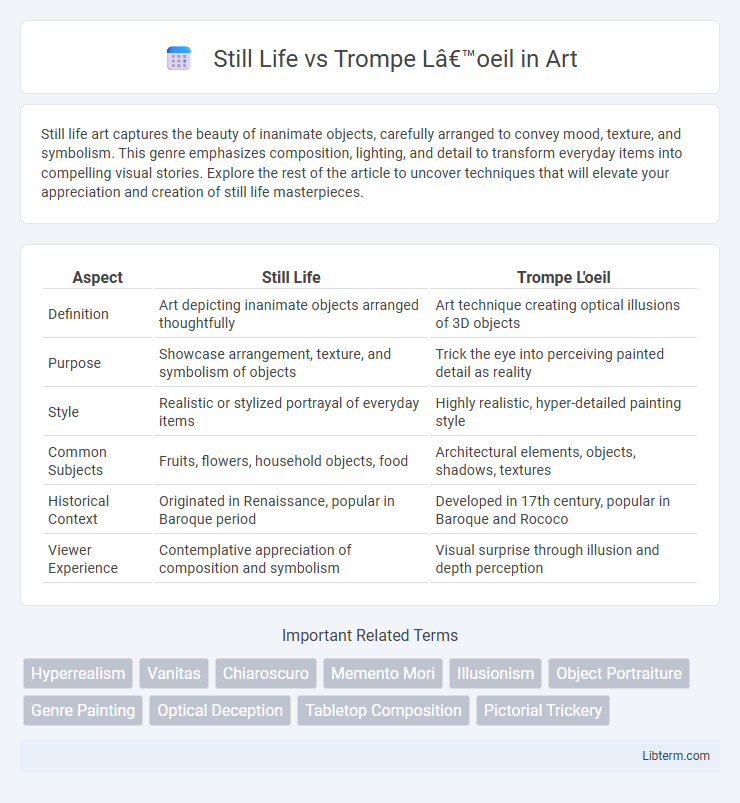Still life art captures the beauty of inanimate objects, carefully arranged to convey mood, texture, and symbolism. This genre emphasizes composition, lighting, and detail to transform everyday items into compelling visual stories. Explore the rest of the article to uncover techniques that will elevate your appreciation and creation of still life masterpieces.
Table of Comparison
| Aspect | Still Life | Trompe L'oeil |
|---|---|---|
| Definition | Art depicting inanimate objects arranged thoughtfully | Art technique creating optical illusions of 3D objects |
| Purpose | Showcase arrangement, texture, and symbolism of objects | Trick the eye into perceiving painted detail as reality |
| Style | Realistic or stylized portrayal of everyday items | Highly realistic, hyper-detailed painting style |
| Common Subjects | Fruits, flowers, household objects, food | Architectural elements, objects, shadows, textures |
| Historical Context | Originated in Renaissance, popular in Baroque period | Developed in 17th century, popular in Baroque and Rococo |
| Viewer Experience | Contemplative appreciation of composition and symbolism | Visual surprise through illusion and depth perception |
Introduction to Still Life and Trompe L’oeil
Still Life art captures inanimate objects arranged to emphasize composition, texture, and lighting, often symbolizing deeper meanings such as mortality or abundance. Trompe L'oeil, a technique meaning "deceive the eye" in French, employs hyper-realistic imagery to create the optical illusion that depicted objects exist in three dimensions. While still life centers on representation and symbolism, Trompe L'oeil extends the viewer's perception by mimicking reality with astonishing accuracy.
Historical Origins and Evolution
Still life painting emerged during the Renaissance, emphasizing detailed depictions of inanimate objects to explore composition and symbolism, while Trompe L'oeil originated in ancient Greece and Rome as an optical illusion technique designed to deceive viewers into perceiving painted elements as three-dimensional. The evolution of still life saw its peak in the Dutch Golden Age, where artists meticulously portrayed everyday items to convey moral messages, whereas Trompe L'oeil gained popularity in Baroque art, pushing the boundaries of realism and viewer interaction. Both genres significantly influenced artistic techniques by advancing attention to detail and challenging perceptions of reality through meticulous realism and perspective mastery.
Defining Still Life: Characteristics and Styles
Still life is a genre of painting that captures inanimate objects arranged in a composition, emphasizing texture, light, and form to evoke a sense of realism or symbolic meaning. Characterized by meticulous attention to detail, still life artworks often include everyday items such as fruits, flowers, vessels, and other household objects, showcasing a variety of styles from classical realism to modern abstraction. This genre contrasts with trompe l'oeil, which employs hyper-realistic techniques specifically designed to deceive the viewer into perceiving painted objects as three-dimensional.
Understanding Trompe L’oeil: Techniques and Purpose
Trompe l'oeil utilizes hyper-realistic painting techniques to create optical illusions that deceive the viewer into perceiving painted objects as three-dimensional. This art form leverages meticulous attention to detail, perspective, and lighting to achieve a lifelike effect that challenges traditional representational art. The primary purpose of trompe l'oeil is to blur the boundaries between reality and illusion, engaging viewers by transforming flat surfaces into convincing visual experiences.
Key Differences Between Still Life and Trompe L’oeil
Still Life art captures inanimate objects arranged compositionally to emphasize form, texture, and color, often evoking symbolism or aesthetic pleasure. Trompe L'oeil employs hyper-realistic techniques to create optical illusions that deceive viewers into perceiving painted detail as three-dimensional objects or scenes. The key difference lies in Still Life's focus on representation and artistic interpretation versus Trompe L'oeil's intent to trick the eye through illusionistic precision.
Symbolism and Storytelling in Still Life
Still Life paintings harness symbolism to convey hidden meanings through meticulously chosen objects, such as skulls symbolizing mortality or wilting flowers representing the transient nature of life. Unlike Trompe L'oeil, which aims to deceive the eye with hyperrealistic illusions, Still Life invites contemplative storytelling by arranging items that evoke themes of vanitas, abundance, or spiritual reflection. This narrative depth allows viewers to engage with cultural, philosophical, and historical contexts embedded within the composition.
Illusion and Realism in Trompe L’oeil
Trompe L'oeil masterfully employs illusionistic techniques to create hyper-realistic images that deceive the viewer into perceiving three-dimensional objects on a two-dimensional surface. Unlike traditional still life, which emphasizes representation and composition, Trompe L'oeil intensifies realism by mimicking textures, shadows, and perspective with extraordinary precision. This technique blurs the boundary between art and reality, engaging viewers in a visual trickery that challenges perception and highlights artistic virtuosity.
Notable Artists and Masterpieces
Still Life features artists like Caravaggio, whose "Basket of Fruit" exemplifies dramatic realism, while Trompe L'oeil is epitomized by artists such as William Harnett, renowned for "Violin and Music." Notable masterpieces in Still Life emphasize texture and light to evoke sensory experiences, contrasting Trompe L'oeil's hyper-realistic illusions designed to deceive the eye. Both genres celebrate meticulous detail but differ in purpose: Still Life captures symbolic narratives, whereas Trompe L'oeil challenges perception with striking visual trickery.
Influence on Contemporary Art
Still Life's emphasis on everyday objects shapes contemporary art by encouraging detailed observation and thematic exploration of domesticity and mortality. Trompe L'oeil, with its hyper-realistic illusions, influences modern artists to challenge perception and blur the boundaries between reality and representation. Both genres inspire contemporary creators to merge meticulous technique with conceptual depth, driving innovation in visual storytelling.
Choosing Between Still Life and Trompe L’oeil
Choosing between still life and trompe l'oeil depends on the artist's intent and desired viewer interaction. Still life emphasizes composition, symbolism, and the realistic depiction of inanimate objects to evoke mood or narrative. Trompe l'oeil, a hyperrealistic technique, aims to deceive the eye by creating optical illusions that challenge perception and invite closer examination.
Still Life Infographic

 libterm.com
libterm.com